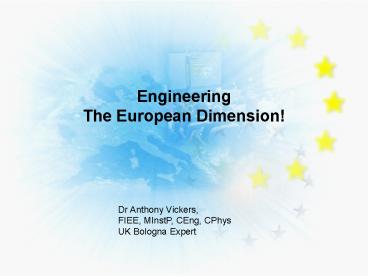Engineering The European Dimension PowerPoint PPT Presentation
1 / 24
Title: Engineering The European Dimension
1
Engineering The European Dimension!
Dr Anthony Vickers, FIEE, MInstP, CEng, CPhys UK
Bologna Expert
2
"In the decade up to 2020 European higher
education has a vital contribution to make in
realising a Europe of knowledge that is highly
creative and innovative... Europe can only
succeed in this endeavour if it maximises the
talents and capacities of all its citizens and
fully engages in lifelong learning as well as in
widening participation in higher education."
Ministers responsible for Higher Education in the
countries participating in the Bologna Process,
Leuven/Louvain-la-Neuve Communiqué, April 2009
3
What is the way forward for Higher Education?
- Simply put it is to continue to provide high
quality Higher Education based on sound
pedagogical principles and transparent to
scrutiny through Quality Assurance procedures. - But how does the Bologna Process fit in?
- Three cycles of degrees
- ECTS
- Diploma Supplements
- European Higher Education Area
4
The Bologna Process
The purpose of the Bologna process is to create
the European higher education area by harmonising
academic degree standards and quality assurance
standards throughout Europe for each faculty and
its development. The name is based on the fact
that the process was proposed at the University
of Bologna with the signing, in 1999, of the
Bologna declaration by ministers of education
from 29 European countries in the Italian city of
Bologna.
The process is assisted in all participating
countries by Bologna Experts
5
Leuven/Louvain-la-Neuve 2009
- We believe that mobility of students, early stage
researchers and staff enhances the quality of
programmes and excellence in research it
strengthens the academic and cultural
internationalization of European higher
education. - Therefore, mobility shall be the hallmark of the
European Higher Education Area. We call upon each
country to increase mobility, to ensure its high
quality and to diversify its types and scope. In
2020, at least 20 of those graduating in the
European Higher Education Area should have had a
study or training period abroad.
6
(No Transcript)
7
The 10 Action Lines
- 1. Adoption of a system of easily readable and
comparable degrees - 2. Adoption of a system essentially based on two
cycles - 3. Establishment of a system of credits
- 4. Promotion of mobility
- 5. Promotion of European co-operation in quality
assurance - 6. Promotion of the European dimension in higher
education - 7. Lifelong learning
- 8. Higher education institutions and students
- 9. Promoting the attractiveness of the European
Higher Education Area - 10. Doctoral studies and the synergy between the
EHEA and ERA
8
The tools
- ECTS a credit system originally designed to
provide a measure for the workload undertaken by
a transfer student. Now being established as a
credit accumulation system. - 1st cycle 180 credits, normally 3 years
- 2nd cycle 60-120 credits, normally 1 or 2 years
- What is a year?
- Learning Outcomes a shift from teacher based
to student based course descriptions in terms of
what the student can do - Diploma Supplement a standard supplementary
document designed to make degrees transparent.
9
How does Engineering in the UK score regarding
the Bologna Process ?
10
Mobility
- Social sciences, business studies and law was the
most popular group of subject areas for Erasmus
students, followed by humanities and arts in
second and engineering, manufacturing and
construction in third place. - Erasmus also enables students at higher education
institutions to spend a placement period of
between 3 months (or at least two weeks for
students in short-cycle higher vocational
education) and 12 months in an enterprise or
organisation in another participating country. - With 3,389 Erasmus student trainees at placements
France was the biggest sender, followed by the UK
(2,755) and Germany (2,733). As in study
mobility, Spain was the most popular destination
for Erasmus student trainees, receiving 3,298
over the year, with the UK in second place
(3,145), followed by Germany (3,021). - The most popular sector for Erasmus student
trainees was the professional, scientific and
technical sector, followed by the education
sector.
11
How do you fair?
- What would one find in the first few hits if you
search your University web site using the search
engine provided by your University on the
following words? - Bologna
- ECTS
- Diploma Supplement
- EHEA
- Erasmus
- Mobility (study or work placement)
12
Taking a positive Attitude
What might be the advantages of a positive
attitude?
13
- Transparency and visibility
- Through the Diploma Supplement
- Defining the teaching year
- Curriculum Development
- A European dimension (ie working in the EU as an
Engineer) - Erasmus Mundus
- Recruitment
- 46 Countries are adopting BAMA.
- What is your recruitment plan?
- Promoting and defining MEng
- Employability
- Are you really missing out a chance for the EU to
fund your employability programme for students? - Staff Development
- How many of your new academics have used mobility
to develop their teaching/research careers?
14
(No Transcript)
15
Examples from the TREE project
16
The Tuning Project
17
ECCE Education Task Force
First results
of the Tuning Project with the participation of
EUCEET and ECCE
Prof. Iacint MANOLIU (UAICR) ECCE Task Force
Education Chairman
42nd ECCE meeting, November 11th 12th,
2005, Istanbul, Turkey
18
One of the hundreds e-mails received during the
EUCEET-ECCE-Tuning exercise I am the Dean and
therefore my answers are official. Can you tell
me what will the others say that can be different
from the official answer?
19
EUCEET Generic Competences RANKING, Academics
Decreasing ranking
20
(No Transcript)
21
22
(No Transcript)
23
Bologna Process Web Site
http//www.ond.vlaanderen.be/hogeronderwijs/bologn
a/
24
The End

